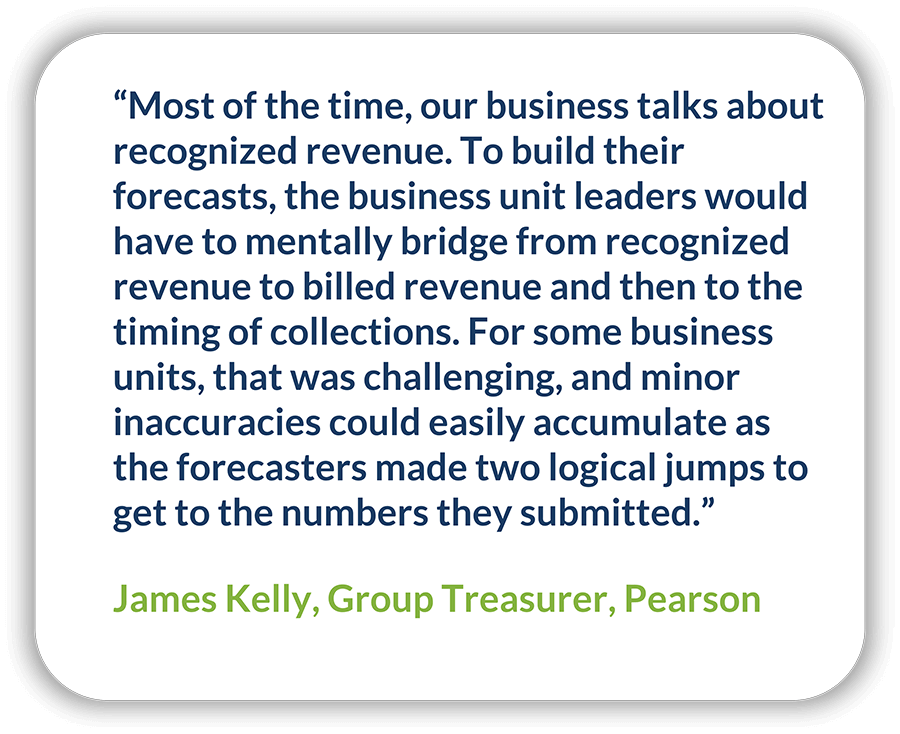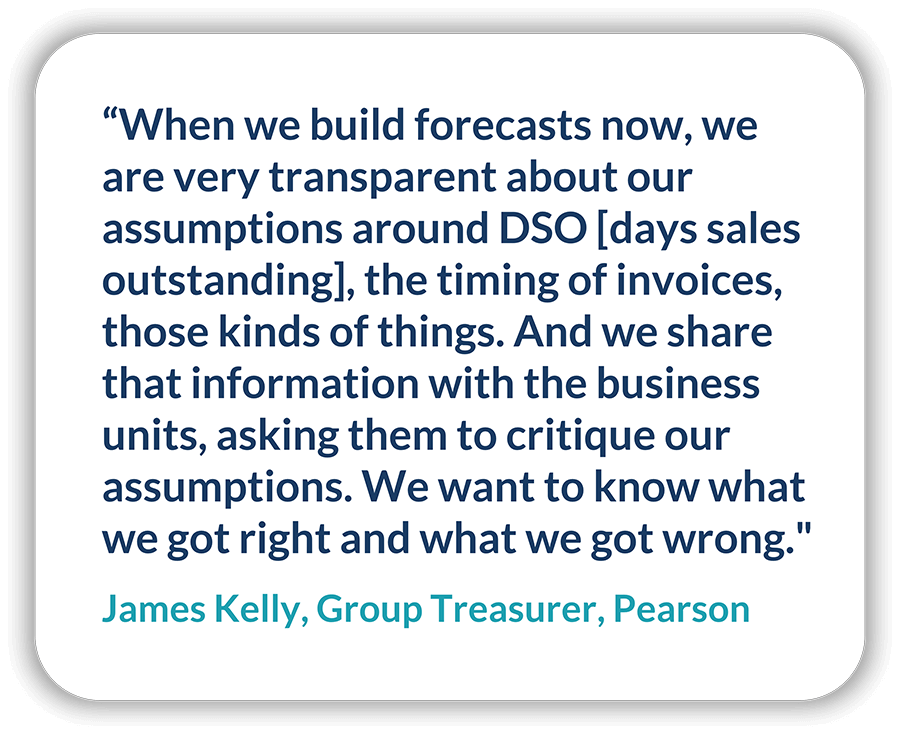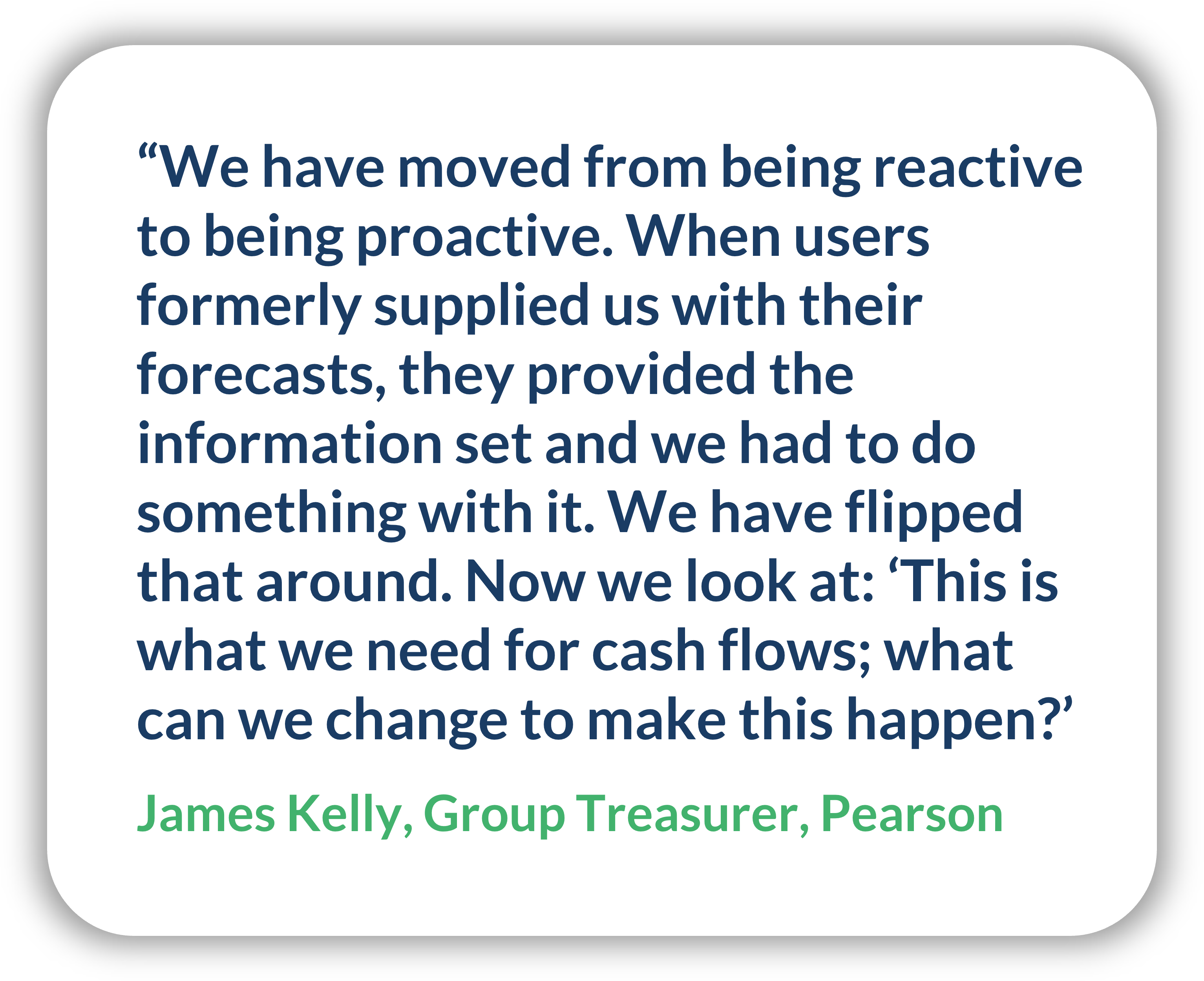Congratulations to Pearson, winner of the 2024 Silver Alexander Hamilton Award in Liquidity Management!
Note: This article was originally published by Treasury & Risk Editor in Chief Meg Waters, based on her interview with the treasury team at Pearson. You can view her original article here: Centralized Cash Forecasting Puts Treasury Learning to Work (treasuryandrisk.com)
Interview Participant
- James Kelly, Group Treasurer, Pearson
Early in the Covid-19 pandemic, London-based learning provider Pearson realized it needed to update its cash forecasting processes. “We provide educational content and assessments for around 160 million learners in more than 150 countries around the world,” explains group treasurer James Kelly. “We offer materials and services for many different facets of education—from public school curricula to language testing for immigration services. Through all our business units, we help learners improve their lives.”
It’s noble work that results in a business with many moving parts, which complicates forecasting. “There are some businesses where cash flows are super predictable, but at Pearson, our different business units have very different working capital dynamics, and cash flows can be difficult to predict,” Kelly explains. “In the medium term, we have a good record of converting profit to cash flow, but on a day-to-day basis, profit and net cash flow are not necessarily correlated.”
Historically, Pearson relied on the business units to forecast what they expected their cash flows to be. However, in 2020, as some geographies moved to a shared-services model, the decentralized forecasting became less sustainable. “The people remaining in the business units had less bandwidth for treasury tasks,” Kelly says.
Another challenge was that in the dispersed forecasting environment “it was difficult to achieve consistency in outlook across divisions,” he adds. “Corporate treasury was receiving dozens of submissions from different teams. We would consolidate them into a single companywide forecast, and as we did so, we might adjust the numbers to calibrate for differences in perspective. For example, we might know the person looking after one division of Pearson is very optimistic, while the person responsible for another division tends to be pessimistic. The more changes we made to accommodate these differences, the more complicated the process became.

“One final issue is that we were asking people to operate in a language they were not used to thinking in,” he continues. “Most of the time, our business talks about recognized revenue. To build their forecasts, the business unit leaders would have to mentally bridge from recognized revenue to billed revenue and then to the timing of collections. For some business units, that was challenging, and minor inaccuracies could easily accumulate as the forecasters made two logical jumps to get to the numbers they submitted.”
This legacy approach to forecasting was not agile enough to help Pearson react to a rapidly evolving business environment. Treasury, finance, and IT launched an initiative to build data-driven decision-making in cash forecasting and collaborated on a comprehensive needs assessment. They decided to find a tool that would enable centralization of global cash forecasting while reducing most of the legacy process’s manual work. At the same time, they wanted to ensure that the tool would not require a lot of IT effort.
They decided to roll out CashOptix from TIS, a software-as-a-service (SaaS) tool that could connect to Pearson’s existing treasury management and enterprise resource planning (ERP) systems. Through collaboration with TIS and banking partner Citi, Kelly’s team developed a functioning prototype in less than 30 days. They soon began using the tool for basic forecasting.
“CashOptix generates a forecast based on historical data,” Kelly says. Bank statements flow into the company’s treasury management system via API. “We were already importing statements from different banks into the treasury management system. They came in slightly different formats, and the system had rules to standardize them for reconciliation purposes. It didn’t make sense for us to re-create that exercise and maintain those rules in two different systems.” So, once the data is standardized, the treasury management system exports it to CashOptix.
The forecasting tool also uses accounts payable (A/P) and accounts receivable (A/R) data from the ERP system. “An automated process pulls out key information and loads it into the TIS solution,” Kelly says. CashOptix produces trend-based cash flow predictions, then Kelly adds information on large transactions and other events the system wouldn’t know about.
“The adjustments I make typically revolve around high-value, one-off transactions such as dividend payments, acquisitions, or divestitures,” Kelly says. “These have to be forecast manually because they are not suitable for trend analysis. Sometimes I also know about upcoming initiatives that need to be overlaid on top. And I may make adjustments as a sanity check: I may strip out the intercompany transactions from the forecast and ask, looking only at external flows, ‘Does this add up to the number I would expect based on our revenue figures?’ I make these changes in a CSV file, then import them into CashOptix.”
The result of this process is an online report. Its top half is a graphical view of cash flows—whether for a group of business units, a group of bank accounts, or an individual bank account. The bottom half shows details of the cash flows that can be sliced and diced in many ways. “You can look at it from an entity perspective and then, within the flows, see multiple levels of granularity, even down to the individual customer level,” Kelly says.

“One benefit of this approach is that, because the same team produces all the numbers, they are consistent and coherent,” Kelly explains. “Nobody has to come in behind us to calibrate it.” That said, treasury does not produce forecasts in a vacuum. “When we build forecasts, we are very transparent about our assumptions around DSO [days sales outstanding], the timing of invoices, those kinds of things. And we share that information with the business units, asking them to critique our assumptions. We want to know what we got right and what we got wrong.”
This leads to continuous improvement of the forecasting process. “The cash flow forecast is partially about cash management and partially about validating our understanding of the business and its drivers,” Kelly says. “If my cash position today is £3 million more than I had yesterday and £2 million more than I forecast, those numbers don’t tell me much about what’s happening in the business. It’s much more interesting to wonder, ‘I have more cash than I expected. Is that because we reduced DSO? Is it because of a one-off payment we received?’ I can look at data points that have similar characteristics—using AI [artificial intelligence] ‘clustering’—and determine whether a variance is an outlier, or something foundational to my forecast isn’t quite right. We routinely test the assumptions underlying our forecast, which helps us better understand the business.”
That understanding, in turn, helps Kelly’s team improve Pearson’s performance. “One of the biggest benefits of our new forecasting process is that we can manage cash flows really precisely,” he says. “We’ve done a good job of aligning the way we track cash flows against the way the groups’ cash flows work, in real time. This year our adjusted cash conversion has been 102 percent. Last year, it was 99 percent, and the year before that it was 101 percent. We can manage cash precisely because we can see, as we approach period-end, whether we really need to push to make sure receivables come in, or whether we can make payments because we have the inflows.”

Their granular visibility into cash flows has enabled treasury to cut borrowing costs by more than US$100 million annually, to increase yield on excess cash, and to finetune their use of foreign exchange (FX) swaps. “The key for me,” Kelly says, “is that we have moved from being reactive to being proactive. When users supplied us with their forecasts, they provided the information set and we had to do something with it. We have flipped that around. Now we look at: ‘This is what we need for cash flows; what can we change to make this happen?’
“For example,” he continues, “we might want to push A/P out by three days because that will allow us to deposit excess cash for two weeks rather than 10 days and get better yield. Or we might contact the A/R team and let them know that if they can accelerate payment on a big receivable due in 10 days, we will save a certain amount by not borrowing as much on our revolving credit facility. We have moved from being forecast takers to forecast makers.”
Kelly concludes with a couple more examples: “People often think about the interest impact of an action without thinking about the overall funding impact,” he says. “Suppose we receive a payment of £10 million 10 days late. It’s a few days at a few percentage points of interest, so timing may not be a huge driver of behavioral change. But if the due date is in the first half of the year and the date we are paid is in the second half, then we have a problem.
“Likewise, if we make a large inventory purchase in June rather than in July, the interest impact may not be big, but the messaging impact is quite significant. That’s something the inventory or A/R team may not understand. My experience has been that treasury can bring a different perspective to some of these challenges, helping ensure the company maintains good discipline around cash flows and everyone understands their impact on the broader cash flow ecosystem.”



